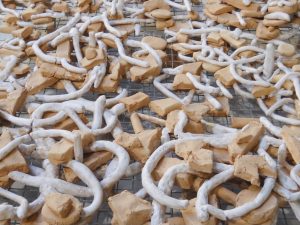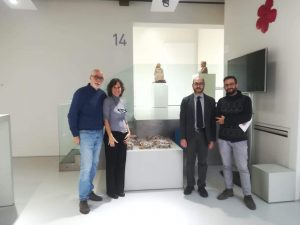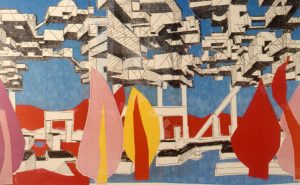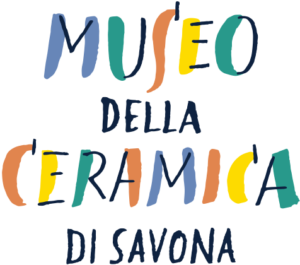A collaborative project between the Ceramics Museum of Savona, the Architecture and Design Department of the University of Genoa and the Fonds de Dotation Denise et Yona Friedman
By Tiziana Casapietra

For the 2003 edition of the Biennale of Ceramics in Contemporary Art we invited, amongst others, Hans Ulrich Obrist to work with us. At that time, he was a curator for contemporary art at the Musée d’art moderne de la Ville de Paris. The aim of all the curators involved in the project was to nominate artists to work with the Albisola traditional ceramics laboratories on projects to be included in an itinerant biennial exhibition. Yona Friedman was one of the artists nominated by Obrist.
Friedman came to Albisola, Ligurian Riviera, Italy, in the summer of 2002 and stayed for the time needed to make a ceramic model of his “City” in collaboration with the Ceramiche San Giorgio laboratory in Albissola Marina. Friedman made his model alongside Giovanni Poggi, the laboratory proprietor. In those days Vasif Kortun was with us too, then director of the Platform Garanti contemporary art center in Istanbul, who had also been invited as a curator for the Biennial. I remember Yona Friedman as a joyful and friendly presence with whom, in addition to discussing his work and witnessing its realization, we visited the main art centres in the area and spent pleasant times together discussing art, architecture, and his vision of the world.
Through the proposed project, Yona Friedman intended to translate his idea of “Ville Spatiale” (Spatial City) into clay, a material that defines the past and present history of this part of western Liguria. In the late 1960s this idea introduced Friedman’s vision of an elevated urban space where people could live and work in homes of their own design and where cities could evolve and grow while limiting the use of the earth’s surface.
Friedman spent his long life promoting a new vision of architecture that he imagined as a spontaneous accumulation of spaces and buildings freely devised by their own inhabitants. In this regard I would like to refer to some of his own writing about the model of a ceramic city entitled Città (City) and made in Albisola.
“It is quite difficult to visualize this kind of randomly unplanned architecture other than through models. Architectural models can eventually become works of art and I generally make use of all kinds of materials not originally intended for modelmaking: corks, boxes, mosaic, paper rolls, lampshade-rings, etc. It is their assembly that makes the models. I was naturally delighted when I was asked to try using ceramics.”
In the following words Friedman talks about his vision of architecture and art, of how the versatility of the clay facilitated experimenting with what he calls the “aesthetic of inexactitude, of the irregular”.
“My models of cities in ceramics are very far from realistic representations (in the sense of mainstream architecture). Clay as a material, its versatility, its heaviness suggested new forms to me; forms that were very different to the drawings of the project they were due to represent. The accent here lies more on the ideas. The compositions in space I happened to shape in clay led me to improved shapes in architecture, breaking away from regular forms and industrial precision towards an aesthetic of inexactitude, of the irregular. The difference is similar to that of vernacular buildings in clay, in dry mud compared with industrialized ‘prefabs.’ I do not know whether the objects I made in clay are beautiful or not (how does one define ‘beauty?’). What I hope is that they might encourage a few people (even some architects) to continue this line of thought, discovering new potentials for the man-made environment.”
Città has been part of the Ceramics Museum of Savona’s permanent collection since 2014. When I started working at the Museum in 2018, I wondered how this work could be better appreciated using the technologies available today. It seemed to me that it would be nice to try to experience the ceramic city just as Friedman had imagined it, and I thought it likely that we could create some kind of similar experience with the help of virtual reality.
I invited Professor Niccolò Casiddu, director of the Architecture and Design Department of the University of Genoa, to collaborate with us to come up with a way of simulating a visit to the city, which would allow visitors to become tiny versions of themselves and enter into that ceramic model and be guided on a discovery of the “Ville Spatiale” by Friedman himself. “Hello Niccolò. I’d like to enable the museum visitor to travel inside Yona Friedman’s ceramic city. Inside the city I would like them to meet and listen to him talking about his utopias. I have attached the ceramic pieces of his that we have at the Museum. I look forward to hearing from you. T.” 23/02/2018
Before proceeding with the project, we consulted Friedman who was already quite elderly at that time. He was immediately enthusiastic about the proposal and couldn’t wait to see how the university students would interpret his work using new technologies. “Dear Tiziana, thank you for your message. I think that virtual Reality presentation is excellent. I saw some other models of mine through that system, and I am very curious about how these ceramic models look that way. I think it is the best way to present architecture. I was glad to have the photos, I liked them. I am till beginning of March in Pasadena, with my daughter. I will try to shoot a short self-video and send it to you. Have you a deadline date? All the best, Yona”. 25/06/2018
Upon receiving Friedman’s positive response, Professor Casiddu began to involve a group of young researchers from his department and the experimental project got underway. The students visited the Museum to see the work and imagine what kind of experience of visiting and living in Friedman’s city they could create through virtual reality viewers.

Unfortunately, two important events have since taken place. The first was the deterioration of Friedman’s health which led to his death. Although he was able to follow and contribute to the start of our project, he was unable to see either the evolution or the conclusion. Fortunately, two people who were very close to him, his daughter Marianne Polonsky Friedman and his close collaborator Jean Baptiste Decavele, continued to follow the project closely with the same attention and empathy. In addition to the long conversation I had with Marianne Friedman, in which with intensity and generosity she told us about her father seen through the eyes of a daughter, Decavele kindly allowed us to show our audience the film he made, “A Home”, in which Yona Friedman shares his vision of architecture and the world with the public. Decavele also provided us with images of Friedman’s drawings illustrating the concept of the “Ville Spatiale” which were then included in the virtual experience.
A home is not a house
“…to make a home, you have to improvise, a home is not a house…” Yona Friedman.
The second fact that characterized this experimental project between the Museum and the University was the pandemic, which slowed contact, forced all of us to work remotely and share the various stages of the project by meeting through available Internet platforms.
Now that the virtual visit project to “Città” is finished, it can be partially experienced through a short demo available online at this page. The complete virtual experience can be had by wearing the appropriate glasses as soon as pandemic related restrictions allow.

Our hope is that soon it will be possible for all those who wish to, to visit the Museum, appreciate Yona Friedman’s ceramic jewel live, and then lose themselves in a virtual visit to his city, allowing themselves to be lead by his own words. The students tiptoed into this project knowing the greatness of this giant of architecture and contemporary thought. At first, they thought they might insert a virtual whole figure of Friedman inside his city. But then, after his passing, they thought it was more respectful to leave only his words accompanied by sound. The experience they have built is dreamlike, disorienting; the evocative sound that accompanies the route through their virtual reconstruction of the city was made with ceramic instruments by Jorge Hernandez. The poignant speech of an already elderly Friedman guiding us inside his vision of architecture and the world was kindly provided by Louisiana Channel.
“I am often asked what should be my advice to the young architect: Understand that it is not the architect the important person in the process; Adapt, learn to adapt to the context and the context is so more complicated than you feel or see it the textbook, you experience it directly, accept it. So my advice is very simple, architect can be the artist.”
I think that the students have interpreted Yona’s words superbly and I am sure that he, from his celestial “Spatial City”, is also enthusiastic about it.
Savona, 23 July 2021
Tiziana Casapietra
Translated from Italian by Rosemary McKisack
Click here to:
Yona Friedman (1923-2019) was a Hungarian-born French architect. Starting in 1958 with his manifesto “L’Architecture Mobile”, he formulated and championed the idea that the inhabitant should be the sole originator of his own living premises. His theories influenced avant-garde groups like the Japanese Metabolists, Archigram and many more. He has been the subject of multiple exhibitions and retrospectives and participated in many Biennales, solo exhibits in museums with his last one at the MAXXI in Rome in 2017, and the installation “Summer House” in 2016 at London’s Serpentine Gallery. His drawings and models are part of the permanent collections at MOMA in New York, the Pompidou Centre in Paris, the Victoria and Albert Museum in London and the Getty Institute in Los Angeles.
He received, amongst other prizes, the Architecture Award from the Berlin Academy, the Grand Prize for Design from the Prime Minister of Japan and the “Scroll of Honor” from the UN’s Habitat programme. He was appointed Honorary Fellow of the Royal Academy of The Hague, and Commander of the National Order of Arts and Letters in France.
He taught at MIT, Harvard, Princeton, Columbia, UCLA, Berkeley and other institutions. His work continues to inspire and teach a new generation of researchers and architects about their responsibilities to citizens and to the planet.

Images and videos credits (in order of appearance)
1- Yona Friedman, “City”, 2003
2- Left to right: Giovanni Poggi, Vasif Kortun, Tiziana Casapietra and Yona Friedman at Ceramiche San Giorgio laboratory (Albissola Marina, Savona)
3- Yona Friedman and Giovanni Poggi at Ceramiche San Giorgio laboratory (Albissola Marina, Savona)
4- Niccolò Casiddu, Tiziana Casapietra, Marco Ferrante and Omar Tonella at Museo della Ceramica di Savona
5- The Genova University’s scholars developing the VR experience
6- Notes and sketches by the University’s scholars developing the VR experience
7- Film “A home is not a house”, Film by Jean-Baptiste Decavèle, with Yona Friedman, 2018. Film FCF 310 part of “Collection, Fragments”. Courtesy: Fonds de Dotation Denise et Yona Friedman, et Jean-Baptiste Decavèle, all rights reserved © 2018. Downloading of the whole or a part of a protected copyrighted film, without the consent of the copyright holder, is prohibited.
8- Carmen Andriani, Tiziana Casapietra, Niccolò Casiddu and Maria Cecilia Reyes during the testing of the VR tool at DAD, University of Genoa, Italy
9- An excerpt from the VR tour of Yona Friedman’s art work “City” (preview)
10- Yona Friedman, “Ville Spatiale” (drawings). Courtesy Fonds de Dotation Denise et Yona Friedman.
11- Yona Friedman, “Ville Spatiale” (drawings). Courtesy Fonds de Dotation Denise et Yona Friedman.
12- Yona Friedman, “Ville Spatiale” (drawings). Courtesy Fonds de Dotation Denise et Yona Friedman.
Editing: Giulia Macchiarella
The project “Inside Yona Friedman’s ceramic city” is the result of a collaboration between


With the support of
![]()